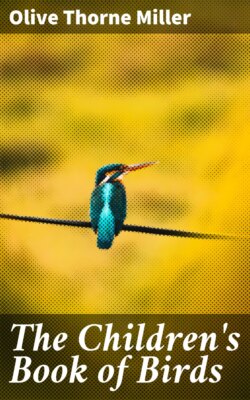Читать книгу The Children's Book of Birds - Olive Thorne Miller - Страница 18
На сайте Литреса книга снята с продажи.
X
ОглавлениеTable of Contents
SOME OF HIS LESSONS
It is very easy to catch the birds teaching their little ones to exercise their wings and to fly together. You will see the young birds sitting quietly on fences or trees, when all at once the parents begin to fly around, with strange loud calls. In a minute every youngster will fly out and join them. Around and around they all go, hard as they can, till their little wings are tired, and then they come down and alight again.
Once I saw a young bird who did not go when his parents called. All the others flew around many times, and I suppose that young one thought he would not be noticed.
But mothers' eyes are sharp, and his mother saw him. So when she came back, she flew right at her naughty son, and knocked him off his perch. The next time she called, he flew with the rest. This was a crow mother.
I have seen a bluebird just out of the nest, taught to follow his father in this way. He stood on a small tree, crying for something to eat, when his father came in sight with a beakful of food. He did not feed him, but flew past him, so close that he almost touched him, and alighted on the next tree, a little beyond him.
BLUEBIRD
The little bluebird saw the food, and at once flew after it, perched beside his father, and was fed. Then the old bird left him, and in a few minutes he felt hungry, and began to call again.
I kept close watch, and soon the father came and did the same thing over. He flew past the young one with an insect in plain sight in his beak, and perched on another tree still farther along in the way he wanted the little one to go.
The hungry baby followed, and was fed as before. In this way he was led to a big tree the other side of the yard, where the rest of the family were, and where they all spent the night.
An old robin wanted to teach her young one to bathe. She brought him to a dish of water kept for their use by some people who were fond of birds. The little one stood on the edge and watched his mother go in, and splash and scatter the water. He fluttered his wings, and was eager to try it for himself, but seemed afraid to plunge in.
At last the mother flew away and left him standing there, and in a moment came back with a worm in her mouth. The young robin was hungry, as young birds always are, and when he saw the worm, he began to flutter his wings, and cry for it.
But the mother jumped into the middle of the water dish, and stood there, holding the worm in his sight. The youngster wanted the worm so much that he seemed to forget his fear of the water, and hopped right in beside her. She fed him, and then began to splash about, and he liked it so well that he stayed and took a good bath.
Birds, as these stories show, teach their little ones by coaxing, and not by driving them.
An Englishman, Mr. Lloyd Morgan, once had some ducks and chickens hatched away from their mother, to see how much their parents had to teach them.
He found that these little orphans had to be taught to pick up their food, and to know what is good to eat. He had to show the young ducks how to dive, and teach all of them that water is good to drink.
To see if chickens had to be taught the hen language, he put them out by their mother when they were a few days old.
The hen was going about with her brood, all brothers and sisters of Mr. Morgan's chicks, and she was quite ready to adopt the new ones. She clucked and called to them with all her might, but they did not come. They acted as if they did not hear her. When the others ran and crept under her wings to be brooded, the strangers looked on, but did not think of going too.
They did not understand the calls or the ways of their own mother. They had not been taught.
A careful watcher will see the birds teach these things, and many others as interesting. But no one will see anything unless he is quiet, and does not frighten them.
